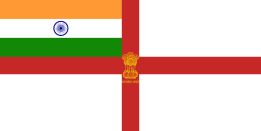INS Nilgiri
| History | |
|---|---|
| Name: | INS Nilgiri |
| Namesake: | Nilgiri Hills |
| Ordered: | 1964 |
| Builder: | Mazagon Docks Ltd, Mumbai |
| Laid down: | October 1966 |
| Launched: | October 1968 |
| Commissioned: | 3 June 1972 |
| Decommissioned: | 1996 |
| Fate: | Sunk in a Sea Eagle AShM test from a carrier-launched Sea Harrier in 1997 |
| General characteristics | |
| Class and type: | Nilgiri-class frigate |
| Displacement: |
|
| Length: | 113 m (371 ft) |
| Beam: | 13 m (43 ft) |
| Draught: | 4.3 m (14 ft) |
| Propulsion: |
|
| Speed: | 28 knots (52 km/h; 32 mph) |
| Range: | 4,000 nmi (7,400 km; 4,600 mi) at 12 kn (22 km/h; 14 mph) |
| Complement: | 267 (incl 17 officers)[1] |
| Sensors and processing systems: |
|
| Armament: |
|
| Aircraft carried: | 1 HAL Chetak |
INS Nilgiri (F33) was the lead ship of her class of frigates. Commissioned on 3 June 1972 into the Indian Navy, she was decommissioned in 1996.
INS Nilgiri was the first major warship built in India keel up. It was built at Mazagon Docks Limited, Mumbai in collaboration with Yarrow Shipbuilders, Glasgow. The collaboration involved designs of the Royal Navy's improved Type 12 general purpose frigate and technical and training support for construction of 6 vessels. The project to build Nilgiri was led by Homi Sethna and Commander (later Rear Admiral) Prakash N Gour. The success of Nilgiri led to the Indian Navy along with Mazagon Docks redesigning the last two ships of the class - INS Vindhyagiri and INS Taragiri to add the Sea King helicopter, ILAS 324 mm torpedo tubes and Bofors ASW rocket launcher.
Decommissioning
INS Nilgiri was decommissioned in 1996. She was sunk on 24 April 1997, in a test firing of a Sea Eagle anti-ship missile by a Sea Harrier Frs Mk.51 taking off from the aircraft carrier INS Viraat.
References
Naval Forces of the World, by Christopher Chant Transition to Triumph - Indian Navy 1965 to 1975, by Vice Admiral GM Hiranandani (retd)
